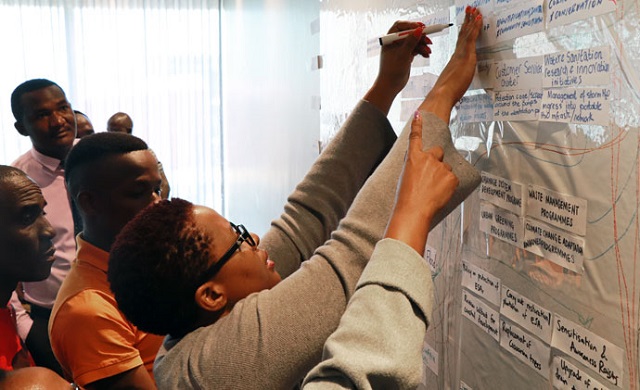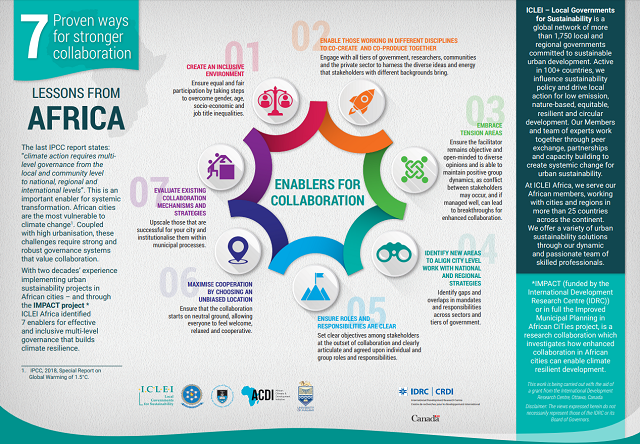
In cities around the world, local officials face multi-dimensional sustainability and resilience challenges and are often responsible for achieving many overlapping mandates. More effective solutions require cross-cutting responses and collaboration across multiple levels of government and sectors.
New research reveals practical ways to collaborate – online and in-person – across levels of government and between the public and private sector to make planning decisions that are responsive to the new urban normal.
Such integrative collaboration, or “multi-level governance,” leads to better outcomes for climate-resilient urban development. Yet it’s easier said than done, as authorities generally work within well-established sectors and departments, each with their own unending list of deliverables, mandates and agendas.
To help this process, ICLEI launched the Improved Municipal Planning for African CiTies (IMPACT) project, funded by the International Development Research Centre. IMPACT explores locally relevant barriers and opportunities to the implementation and maintenance of collaboration mechanisms that facilitate climate-resilient development, focusing on African cities.
Recent findings from the IMPACT project have revealed a set of seven practical factors that enable successful collaboration, some of which have proven especially useful during the COVID-19 pandemic.

1. Create an Inclusive Environment
To ensure equal and fair participation in development policies and projects, cities and project leaders need to take steps to overcome gender, age, socio-economic and job title inequalities. Inclusivity makes for a more legitimate process. In Addis Ababa, Ethiopia, for example, the Urban Natural Assets for Africa Program asked community members to give their input and ideas in redesigning a neglected public space to become a beautiful and functional public park.
The key is to mobilize underrepresented stakeholders who have the capacity to act and contribute, whether in skills, experience, knowledge or mandate. For example, the expertise of someone with indigenous knowledge who deeply understands the local problem being addressed can improve the quality of decisions and may be better able to point out potential conflicts down the line.
2. Enable Co-Creation Across Disciplines
Cities should engage with all tiers of government, researchers, communities and the private sector to harness the diverse ideas, energy and skills that different stakeholders bring – though it’s important that all stakeholders work under shared, agreed-upon goals for a specific project.
As part of the Urban-LEDS II project, we involved community members in three districts in Rwanda to compile Risk and Vulnerability Assessments. They shared their lived experience and knowledge on the population groups most vulnerable to the impacts of climate change. This approach filled the data gaps often encountered in African cities with local, context-relevant knowledge.
As part of The Covenant of Mayors in Sub-Saharan Africa, cities complete similar baseline reports for their Sustainable Energy Access and Climate Action Plans. The initiative uses a participatory and inclusive methodology to collect the needed data. Our team invites stakeholders from different sectors and tiers of government to the same workshop in order to co-assess baselines and co-create action plans.
Such an approach invites all residents to co-produce practical interventions to enhance resilience in their cities. The Future Resilience for African Cities and Lands (FRACTAL) Project has also proved the efficacy of this approach. This research project, led by a consortium of partners including ICLEI Africa, brings together scientists, engineers, government representatives and other stakeholders to co-produce context-relevant climate information in nine cities across sub-Saharan Africa.
3. Embrace Tension Areas
In collaborative processes among many stakeholders, tension and even conflict are inevitable, so taking steps to mitigate power imbalances or conflict upfront is essential. Leaders should instill fair and transparent processes, including decision-making rules or guidelines, from the outset, and ensure that facilitators remain objective and open to diverse opinions. If managed well, tension can lead to breakthroughs for enhanced collaboration.
A great example of this is the Talanoa Dialogues, introduced into international negotiations during COP23 in Fiji in 2017. This was the first time in the UNFCCC process that national governments met with non-Party stakeholders in an official setting. “Talanoa” refers to a style of dialogue practiced in Pacific Island countries that fosters openness and inclusivity. At COP23, the dialogues helped to break the climate deadlock by asking participants to share their stories of climate change. Any criticism and confrontation, often experienced at these meetings, was forbidden.
ICLEI’s Cities and Regions Talanoa Dialogues were launched at the ninth World Urban Forum. Since then, Talanoa Dialogues have been held around the world as a way to take stock of current climate action. These dialogues, designed to support all actors in raising climate ambitions, use storytelling as an accessible way to enable stakeholders to openly report on progress, facilitating participatory and transparent communication.
4. Identify New Areas to Align City, Regional and National Strategies
For climate action, our IMPACT research has revealed the importance of aligning Nationally Determined Contributions (NDCs) with local climate targets, increasing the chances of achieving the NDCs and raising ambition. Officials across ministries and levels of government should look at their current policies and plans to find common objectives and synergies. Local government officials might find that they are already implementing activities that will help meet NDC targets; they just need to consciously align their efforts.
In Malawi, the IMPACT project helped to establish a multi-level governance collaboration between local councils and national authorities. We invited members from Lilongwe City Council and Blantyre City Council, along with district council representatives, to meet with national government representatives in order to unpack both barriers and enablers for improving coordination on implementing NDCs. A roadmap has now been developed for how both tiers of government can improve coordination around the implementation of Malawi’s NDC.
5. Ensure Stakeholder Roles and Responsibilities are Clear
Cities and project leaders should set clear objectives among stakeholders at the outset of collaboration, agreeing on individual and group responsibilities and spreading leadership across multiple actors.
In Nacala, Mozambique, our team conducted a workshop to identify key stakeholders in the city’s Coastal Natural Assets Management Plan. For each action, the group identified lead and supporting stakeholders. The Department of Environment would plant indigenous trees along the coastline to reduce erosion, for example, while the Department of Planning would prohibit infrastructure development to estuaries. This approach ensured collective ownership and accountability and balanced out power dynamics. It also empowered individuals with differentiated skillsets and competencies to execute the collaboration.
6. Maximize Cooperation by Choosing a Neutral Location
Collaboration should start on neutral ground, allowing everyone to feel welcome, relaxed and cooperative. For in-person collaboration, this would mean finding venues not linked to any of the stakeholders. IMPACT often chooses hotels to break from the more formal setting associated with government. During the COVID-19 pandemic, remote meetings have proven helpful in neutralizing location. However, meeting facilitators need to ensure that stakeholders are not burdened by expensive data requirements that may prevent them from fully participating in online processes.
Another useful way to create neutral ground during online workshops is to make use of breakout rooms and place participants from different designations and positions in the same room. Activities like murals, where participants can create collaborative visuals, are also a fun and engaging way to break down power dynamics.
7. Evaluate Existing Collaboration Mechanisms and Strategies
Cities should scale up successful collaboration strategies and institutionalize them within municipal processes. In Malawi, we are implementing a mechanism called for by both city and national government officials that focuses on better integrating local voices within national decision-making through a new communications flow among local councils, and then between these local councils and the national government.
And in our work for the Covenant of Mayors in Sub-Saharan Africa, before starting each Sustainable Energy Access and Climate Action Plan, we conduct an inception meeting to assess the city’s current needs and capacity, existing collaboration mechanisms, potential partners and stakeholders, and resources and data available at the local and national levels.
As cities work toward recovering economically from the COVID-19 pandemic while building resilience, multi-level collaboration is key. These seven factors can help all parties work better together to face a very complex, challenging reality. While the success stories are from African cities, these factors can be applied throughout the global south to build cities that are future-ready, climate-smart and responsive to the needs of everyone.
Adél Strydom is a Senior Communications Officer at ICLEI Africa.
The Improved Municipal Planning in African CiTies (IMPACT) Project, funded by the International Development Research Centre, is an ICLEI research collaboration that investigates how enhanced collaboration in African cities can enable climate resilient development. IMPACT is undertaken in partnership with the African Climate & Development Initiative South Africa; Chinhoyi University of Technology, Zimbabwe; and the University of Malawi.








